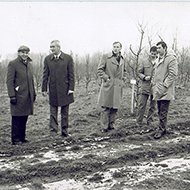History
Čačak region has been known as an area of fruit growing for a long time. A various varieties of apples, pears, plums and even chestnut were cultivated back in the time of Nemanjić dynasty. It is not by chance that in the place of the present location of the Institute, Fruit and grapevine nursery was established in 1898, among the first in the former Kingdom of Serbia. The establishment of the nursery initiated that more attention began to be paid to the fruit cultivation in this area, which contributed to the introduction of newer, better and more productive varieties of fruit trees into production. Also, with the establishment of the nursery, fruit growers have begun to apply the appropriate measures in orchards.
The first Congress of fruit growers of Yugoslavia was held in Čačak in 1932, where the fruit growers gave initiative for the formation of some experimental and/or research organization for fruit growing. The organization should perform research and implement scientific knowledge in practice to improve the Yugoslav fruit production. This proposal was implemented in 1937 with the establishment of the State experimental fruit station in Goražde, as the geographical center of the former Kingdom of Yugoslavia. The first associates of the station were from Čačak: Engr. Milisav Gavrilović and Engr. Gvozden Majstorović.
After World War II, with the change of the social organization in the country, the establishment of scientific and research organizations in fruit culture, in the form of institutes or experimental fruit stations has begun. Among the first in the country, on the proposal of Engr. Milisav Gavrilović, the Ministry of Agriculture of the People's Republic of Serbia, with its decision No. 21867 of 17 July 1946 established the Institute for Fruit Growing and Processing of Fruit, with a mission to solve the basic problems in the field of production, conservation and processing of fruit, especially in the field of planting material production. By establishing the Institute, the Ministry of Agriculture of the People's Republic of Serbia has established four stations in Prokuplje, Novi Pazar, Valjevo and Grocka. These stations were under professional supervision of the Institute from Čačak that implemented research activities on the field through them, which was done up to their abolition in 1955.
In order to create lasting conditions for more solid work on scientific and research topics in the field of fruit growing, the Institute has already since 1948 began intensive work on gathering and collecting of varieties of temperate fruit species. Fruit varieties and rootstocks were collected from the territory of Yugoslavia and from abroad. The largest number of fruit varieties was collected from the following organizations and famous fruit growers of that time:
After World War II, with the change of the social organization in the country, the establishment of scientific and research organizations in fruit culture, in the form of institutes or experimental fruit stations has begun. Among the first in the country, on the proposal of Engr. Milisav Gavrilović, the Ministry of Agriculture of the People's Republic of Serbia, with its decision No. 21867 of 17 July 1946 established the Institute for Fruit Growing and Processing of Fruit, with a mission to solve the basic problems in the field of production, conservation and processing of fruit, especially in the field of planting material production. By establishing the Institute, the Ministry of Agriculture of the People's Republic of Serbia has established four stations in Prokuplje, Novi Pazar, Valjevo and Grocka. These stations were under professional supervision of the Institute from Čačak that implemented research activities on the field through them, which was done up to their abolition in 1955.
In order to create lasting conditions for more solid work on scientific and research topics in the field of fruit growing, the Institute has already since 1948 began intensive work on gathering and collecting of varieties of temperate fruit species. Fruit varieties and rootstocks were collected from the territory of Yugoslavia and from abroad. The largest number of fruit varieties was collected from the following organizations and famous fruit growers of that time:
- Agricultural School in Bukovo near Negotin, Serbia;
- State experimental fruit stations in Goražde, Bosnia and Herzegovina;
- Đuro Nikolić, famous fruit grower from Gugalj village near Požega, Serbia;
- New Jersey Experimental Fruit Station, USA, mainly thanks to the Engr. Mehmedalija Fazlagić from Goražde;
- School Horticultural Farm from Lednice, Czech Republic;
- Research Institute of Pomology and Floriculture from Skierniewice, Poland;
- East Malling Research Station from East Malling, England.

 English
English Srpski
Srpski 














